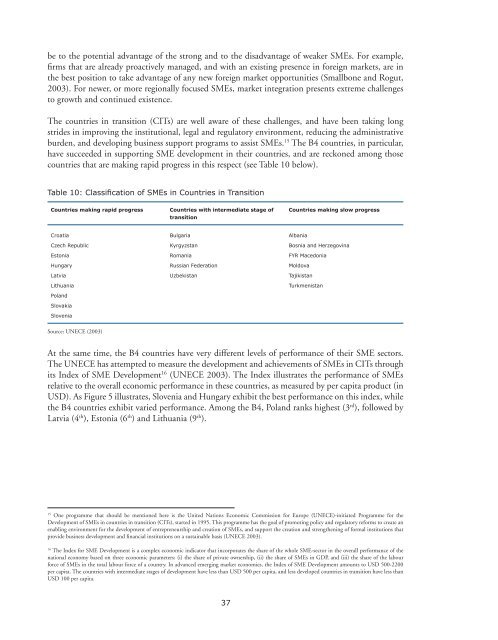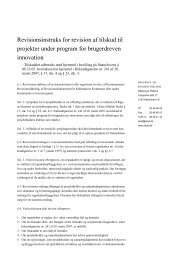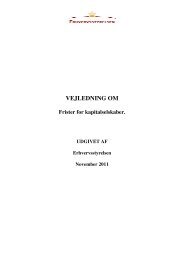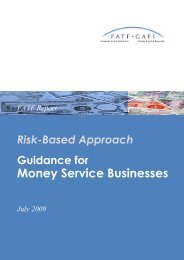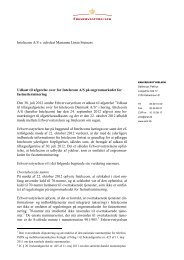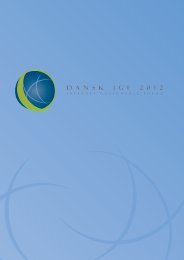Competing in the Single Market - SMEs and ... - Erhvervsstyrelsen
Competing in the Single Market - SMEs and ... - Erhvervsstyrelsen
Competing in the Single Market - SMEs and ... - Erhvervsstyrelsen
Create successful ePaper yourself
Turn your PDF publications into a flip-book with our unique Google optimized e-Paper software.
e to <strong>the</strong> potential advantage of <strong>the</strong> strong <strong>and</strong> to <strong>the</strong> disadvantage of weaker <strong>SMEs</strong>. For example,firms that are already proactively managed, <strong>and</strong> with an exist<strong>in</strong>g presence <strong>in</strong> foreign markets, are <strong>in</strong><strong>the</strong> best position to take advantage of any new foreign market opportunities (Smallbone <strong>and</strong> Rogut,2003). For newer, or more regionally focused <strong>SMEs</strong>, market <strong>in</strong>tegration presents extreme challengesto growth <strong>and</strong> cont<strong>in</strong>ued existence.The countries <strong>in</strong> transition (CITs) are well aware of <strong>the</strong>se challenges, <strong>and</strong> have been tak<strong>in</strong>g longstrides <strong>in</strong> improv<strong>in</strong>g <strong>the</strong> <strong>in</strong>stitutional, legal <strong>and</strong> regulatory environment, reduc<strong>in</strong>g <strong>the</strong> adm<strong>in</strong>istrativeburden, <strong>and</strong> develop<strong>in</strong>g bus<strong>in</strong>ess support programs to assist <strong>SMEs</strong>. 15 The B4 countries, <strong>in</strong> particular,have succeeded <strong>in</strong> support<strong>in</strong>g SME development <strong>in</strong> <strong>the</strong>ir countries, <strong>and</strong> are reckoned among thosecountries that are mak<strong>in</strong>g rapid progress <strong>in</strong> this respect (see Table 10 below).Table 10: Classification of <strong>SMEs</strong> <strong>in</strong> Countries <strong>in</strong> TransitionCountries mak<strong>in</strong>g rapid progressCountries with <strong>in</strong>termediate stage oftransitionCountries mak<strong>in</strong>g slow progressCroatiaCzech RepublicEstoniaHungaryLatviaLithuaniaPol<strong>and</strong>SlovakiaSloveniaBulgariaKyrgyzstanRomaniaRussian FederationUzbekistanAlbaniaBosnia <strong>and</strong> Herzegov<strong>in</strong>aFYR MacedoniaMoldovaTajikistanTurkmenistanSource: UNECE (2003)At <strong>the</strong> same time, <strong>the</strong> B4 countries have very different levels of performance of <strong>the</strong>ir SME sectors.The UNECE has attempted to measure <strong>the</strong> development <strong>and</strong> achievements of <strong>SMEs</strong> <strong>in</strong> CITs throughits Index of SME Development 16 (UNECE 2003). The Index illustrates <strong>the</strong> performance of <strong>SMEs</strong>relative to <strong>the</strong> overall economic performance <strong>in</strong> <strong>the</strong>se countries, as measured by per capita product (<strong>in</strong>USD). As Figure 5 illustrates, Slovenia <strong>and</strong> Hungary exhibit <strong>the</strong> best performance on this <strong>in</strong>dex, while<strong>the</strong> B4 countries exhibit varied performance. Among <strong>the</strong> B4, Pol<strong>and</strong> ranks highest (3 rd ), followed byLatvia (4 th ), Estonia (6 th ) <strong>and</strong> Lithuania (9 th ).15One programme that should be mentioned here is <strong>the</strong> United Nations Economic Commission for Europe (UNECE)-<strong>in</strong>itiated Programme for <strong>the</strong>Development of <strong>SMEs</strong> <strong>in</strong> countries <strong>in</strong> transition (CITs), started <strong>in</strong> 1995. This programme has <strong>the</strong> goal of promot<strong>in</strong>g policy <strong>and</strong> regulatory reforms to create anenabl<strong>in</strong>g environment for <strong>the</strong> development of entrepreneurship <strong>and</strong> creation of <strong>SMEs</strong>, <strong>and</strong> support <strong>the</strong> creation <strong>and</strong> streng<strong>the</strong>n<strong>in</strong>g of formal <strong>in</strong>stitutions thatprovide bus<strong>in</strong>ess development <strong>and</strong> f<strong>in</strong>ancial <strong>in</strong>stitutions on a susta<strong>in</strong>able basis (UNECE 2003).16The Index for SME Development is a complex economic <strong>in</strong>dicator that <strong>in</strong>corporates <strong>the</strong> share of <strong>the</strong> whole SME-sector <strong>in</strong> <strong>the</strong> overall performance of <strong>the</strong>national economy based on three economic parameters: (i) <strong>the</strong> share of private ownership, (ii) <strong>the</strong> share of <strong>SMEs</strong> <strong>in</strong> GDP, <strong>and</strong> (iii) <strong>the</strong> share of <strong>the</strong> labourforce of <strong>SMEs</strong> <strong>in</strong> <strong>the</strong> total labour force of a country. In advanced emerg<strong>in</strong>g market economies, <strong>the</strong> Index of SME Development amounts to USD 500-2200per capita. The countries with <strong>in</strong>termediate stages of development have less than USD 500 per capita, <strong>and</strong> less developed countries <strong>in</strong> transition have less thanUSD 100 per capita.37


